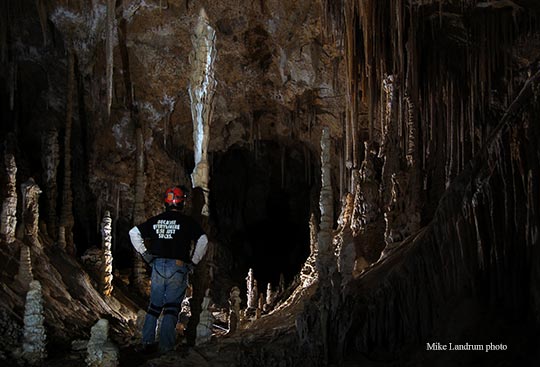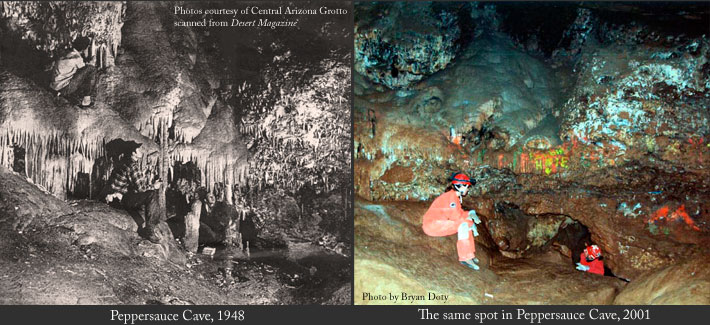Conservation Ethics
August 6, 2012
How Southwest Caves are Unique
Modern Southern Arizona is of course sunny and arid, but it wasn’t always so. During the end of the Paleozoic Era (360ish million years ago), Southern Arizona was largely under water. It was during this time that much the limestone that our caves are formed in was deposited. Massive layers of Redwall Limestone near at the Grand Canyon and Escabrosa Limestone here in southern Arizona were deposited during this time. The creation of the caves came later, but its clear the vast majority of the growth in Arizona caves occurred a very long time ago. In modern Arizona, mineralogic growth in caves occurs very, very slowly. What visitors see when visiting most of our southern Arizona caves is a sort of time capsule from the distant past. For the most part, unspoiled Arizona caves (such as Kartchner Caverns) look much the way they did many thousands of years ago. This is the fundamental reason conservation is so essential. Damage done today will be with the cave for centuries, if not thousands of years.
The Story of Peppersauce Cave
Around Tucson, Peppersauce Cave is well-known as an exciting and popular destination for a quick getaway from the summer heat. Each year, Peppersauce Cave receives upwards of 23,000 visitors, and while the vast majority of Peppersauce guests are respectful, a handful chose to leave behind reminders of their visit. Through the years Peppersauce visitors have been known to encounter endless spools of abandoned twine, spent candles, broken bottles, clothing, syringes, feces (animal and human), condoms, and lots of cigarette butts. (On one clean-up trip several years ago we removed a molding queen size mattress!) The cave, which once would have ranked among the finest in the southwest, is now missing the vast majority of its formations. For the last fifty years, graffiti has been the main decoration in Peppersauce Cave. For all it’s mysteries and adventure, Peppersauce Cave serves as a reminder of the importance of cave conservation.
Of course Peppersauce wasn’t always the way it is today. In 1948 the cave was the little-known discovery of a couple of deer hunters. “We gasped in amazement at the white-coated walls and ceiling and at the long glistening stalactites,” wrote John Priser, one of the earliest explorers of the cave. In his article in Desert Magazine Priser announced the cave to Tucson, complete with directions. Though he certainly didn’t intend harm to the cave, Priser’s story of an underground realm most likely began the stampede of visitors that followed.
In recent years our friends at Central Arizona Grotto in Phoenix have undertaken the task of cleaning Peppersauce Cave. This has entailed the collection of truckloads of trash and the careful removal of decades of graffiti. With the help of cavers from around Arizona, as well as Boy Scouts (who helped with the backbreaking work of removing the mountain of trash), the undertaking has been long and complex, but we think current visitors to Peppersauce Cave will appreciate the difference. If you’re planning a visit to Peppersauce, we hope you’ll consider all the hard work that’s gone into cleaning it. While there, take a trash bag and collect the things left behind by others who aren’t as thoughtful. With Peppersauce Cave, the conservation ethic is to go beyond the “leave no trace” ethic, and instead leave the cave better than you found it.
Conservation = Restoration

Southern Arizona Grotto cavers practice conservation-minded caving, but the effort extends beyond a “leave no trace” ethic. In many caves, such as Peppersauce, cave restoration is now the main focus. Restoration, in short, is a conscious effort to reverse the effects of careless caving. It involves cleaning and repairing formations, protecting cave life so that populations can return to previous levels, and in some cases, limiting access to mitigate further damage.
SAG members have recently organized restoration activities in Cave of the Bells and other caves around Tucson. In addition, some of our members travel seasonally to New Mexico to participate in the High Guads Restoration Project.
If you represent a group (of any size) interested in helping clean or restore a cave, please contact us.
Low Impact Caving
In most cases, simple common sense should be all that’s required to cave with a good conservation ethic. As with backpacking or most any outdoor activity, everything that goes in gets carried out. The ideal is to leave the place just as if you’d never visited.
- Your packs, boots, gloves, helmets, and lint-free clothing, should be washed in soap and thoroughly dried before each and every caving trip to avoid transfer of microbes from other environments. This is especially important in our concern to prevent the potential spread of a fungus known as White Nose Syndrome(WNS) which is responsible for killing bats in states mostly east of us.
- Shoes should have non-marring/non-marking soles so that soles don’t leave marks on cave surfaces. Cave-friendly soles can be light or dark colored, but you should scrape them on a concrete sidewalk before going caving just to see if they’ll mark the cave.
- Always wear durable well-fitting gloves! Check your gloves for mud, dirt, and holes to avoid extra impact. And rather than grabbing handholds along the trail, use a gloved knuckle for balance where possible. Avoid touching anything you don’t have to touch when moving through a cave. Don’t lean on walls, ceilings, or formations. Don’t sit on formations. Touch as little as possible. Use small points of contact for balance rather than dirty open palms.
- Use soft or padded cave packs. Choose gear that is sturdy but compact and avoid excessive straps that can snag or cause unnecessary wear on formations.
- Always spot each other in fragile areas. Spot your companion’s helmets and feet. Be willing to point out unsafe or damaging behavior. It is every caver’s responsibility to ensure that cave environments remain as pristine as possible and that every team member is safe.
- Don’t disturb bats or other cave dwellers. Many critters and insects make their homes in caves and play active roles in the ecology of cave systems. Look before you step and avoid disturbing habitat.
- Know where clean clothes, shoes, and gear are required. To help keep pristine passages clean, avoid wearing general caving attire in these areas.
- Avoid entering pools of water. Tens of thousands of skin fragments and debris fall from each of our bodies every minute. (In addition, the pools of water in Peppersauce Cave are known to be unsafe due to bacteria levels.)
- Please don’t ever smoke or chew tobacco in caves.
- Remove all solid and liquid wastes. Carry a pee bottle. It may seem gross, but please carry urine, feces, spit, vomit, etc. out of the cave.
- Avoid dropping crumbs and food particles. Eat over a plastic bag and carry out your crumbs and debris. Do not eat while moving through the cave.
- Where trails are marked, please stay on established trails so as not impact the cave beyond the trails. Sit inside the trails. Be careful not to set packs outside the trails. Always look for and use the most impacted areas when stopping. Photographers and photo gear should also remain within impacted trails.
- Move carefully through the entire cave, but pay special attention while traveling through delicate areas. Move slowly enough to avoid kicking up dust.
Arizona Cave Protection Law
In 1977, cavers and other interested parties wrote and enacted a cave protection law to help protect Arizona caves from damage. And since many Arizona caves are archaeological sites, a later statute offered further protection to these unique resources. The statutes are 13-3702 and 13-3702.01 of the Arizona Criminal Code Title 13.
Persons convicted under these statutes can be charged with fines up to $150,000. If you’re interested, you can read the law here. Suffice it to say it is illegal to dig in caves for archaeological resources such as pots, or to intentionally damage caves in any way.
